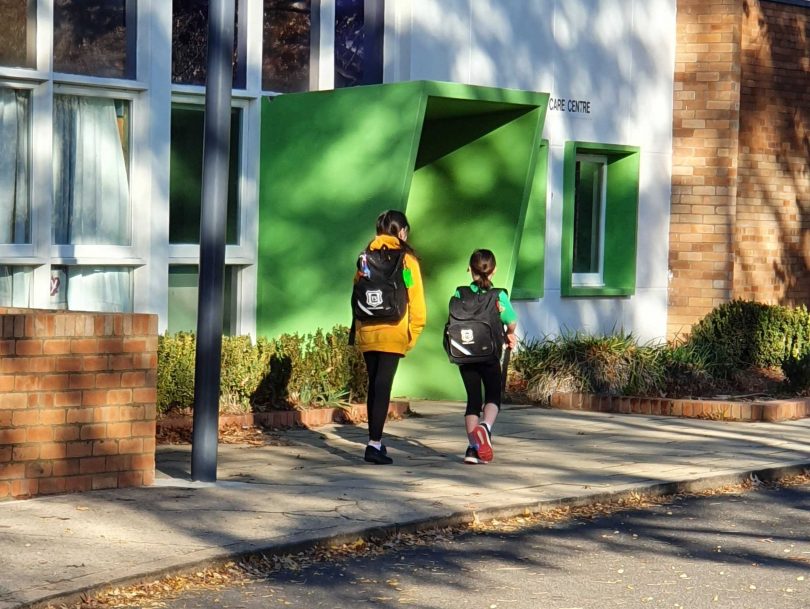
Closing schools would be incredibly disruptive, including to emergency workers who might have to take leave to care for children. Photo: Region Media.
Those of us with children and young people in our care are having to navigate a whole range of concerns due to COVID-19. Key among these is the issue of schools and whether or not they will be closed. And if not now, when?
After all, we are being told as a community to reduce our time with others, practise social distancing, work from home if we can and minimise involvement in events with many people. Schools are places where large numbers of people congregate – often people who like to touch each other and may not be as fastidious in their personal hygiene as they should be.
Given this, it seems important to at least understand why school closures aren’t being implemented yet.
We know closing schools would be incredibly disruptive.
Governments have been planning for pandemics such as this. The Federal Government’s own influenza pandemic plan was released last year (prior to the emergence of COVID-19) and noted that school closures are not generally a recommended action in part due to this disruption.
Federal figures suggest that around 40 per cent of parents would be significantly impacted. When this prospect has been raised recently, concerns cited include the reality that back up care arrangements often involve grandparents – a group at particular risk from COVID-19 due to their age.
The Government’s plan provides useful insights into what is being considered through this pandemic.
Most importantly, there are questions about effectiveness, which seem to be influenced by when this decision is made.
When done proactively, the Government information suggests that school closures may reduce transmission by between 1 per cent and 50 per cent, and may delay an epidemic by a week or two.
Reactive school closures seem to be less effective, with an estimated reduction rate of transmission of between 7 per cent and 15 per cent, although in some rare cases it could be much higher.
The Government’s plan notes that if longer-term closure is considered, it is better to introduce this measure as soon as possible. However, if a short period of closure is implemented, it is preferable to close schools a few weeks before an epidemic’s peak. While early closure is most likely to reduce initial epidemic transmission, if schools close early, it is generally going to be for longer.
Then there is the issue of what it will cost economically.
The plan recognises that while direct costs are moderate, indirect costs to the economy are extreme. There is also a matter of who carries these costs.
Most worrying is the impact on single parents (most often women), and it is likely to be disastrous for those who do not have back up support, don’t have access to paid leave or have precarious employment and income. If school closures do happen, there needs to be some plan to support families left without income due to the need to take on caring responsibilities.
There are also other costs to the potential of us losing a significant proportion of the workforce. This is particularly the case if people in the health care and social assistance industries are unable to work. These are the professions that we will need most to ensure those most vulnerable are being cared for through this crisis. There are concerns about the health impacts of losing a proportion of this workforce at a time when we need them most.
When looking overseas, the evidence on what to do around schools is mixed.
To be effective, some evidence suggests it needs to be early and for a significant period of time. Different countries who seem to have flattened the curve have taken different approaches to do this. In Hong Kong, schools closed in January and will remain closed until at least Easter. Singapore has not moved to mass school closures yet.
So, there is no easy plan to follow, and the move to close schools will end up being a judgement-call by our political leaders. Timing does seem to be important and we will need to be ready to respond if advice changes.
While schools remain open, the key strategy for parents and teachers includes instilling the importance of social distancing with children and young people who are in crowded school environments. Camps, excursions and assemblies are now all banned as one way to embed these new norms.
While schools remain open for now, it is important for us to start to think about how we might respond if things change. The Victorian Premier has previously suggested their schools may have extended holidays, and schools are developing plans on how to deal with the potential of a student or school community member being diagnosed with COVID-19. In NSW, this has seen the temporary closure of individual schools.
Clear, honest and up-to-date communication will be a key way that we will manage this. We are being encouraged to access the NSW government’s health information as the central place for information on a fast-changing situation.
Coming together as a community to support each other becomes more important each day. For all of us, a central focus is helping our children and young people to respond to this real crisis, while also ensuring they feel safe and looked after in a time of uncertainty and fear.
Original Article published by Rebecca Vassarotti on The RiotACT.








